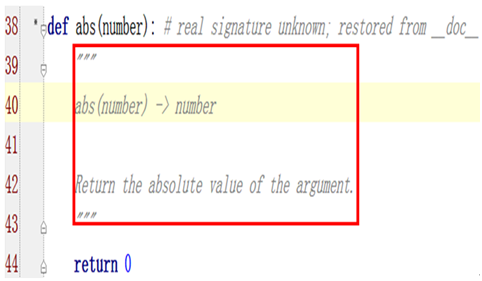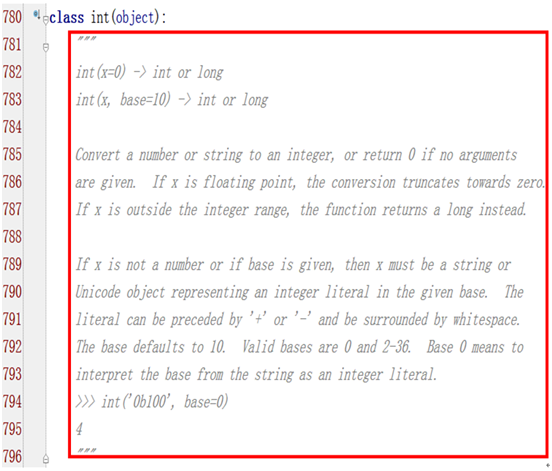我们可以很容易的通过Python解释器获取帮助。如果想知道一个对象(object)更多的信息,那么可以调用help(object)!另外还有一些有用的方法,dir(object)会显示该对象的大部分相关属性名,还有object._ doc _会显示其相对应的文档字符串。下面对其进行逐一介绍。
1、 help()
help函数是Python的一个内置函数。
函数原型:help([object])。
可以帮助我们了解该对象的更多信息。
If no argument is given, the interactive help system starts on the interpreter console.
>>> help()
Welcome to Python 2.7! This is the online help utility.
If this is your first time using Python, you should definitely check out
the tutorial on the Internet at http://docs.python.org/2.7/tutorial/.
Enter the name of any module, keyword, or topic to get help on writing
Python programs and using Python modules. To quit this help utility and
return to the interpreter, just type "quit".
To get a list of available modules, keywords, or topics, type "modules",
"keywords", or "topics". Each module also comes with a one-line summary
of what it does; to list the modules whose summaries contain a given word
such as "spam", type "modules spam".
help> int # 由于篇幅问题,此处只显示部分内容,下同
Help on class int in module __builtin__:
class int(object)
| int(x=0) -> int or long
| int(x, base=10) -> int or long
|
.....
help>
If the argument is a string, then the string is looked up as the name of a module, function, class, method, keyword, or documentation topic, and a help page is printed on the console. If the argument is any other kind of object, a help page on the object is generated.
>>> help(abs) # 查看abs函数
Help on built-in function abs in module __builtin__:
abs(...)
abs(number) -> number
Return the absolute value of the argument.
>>> help(math) # 查看math模块,此处只显示部分内容
Help on built-in module math:
NAME
math
FILE
(built-in)
DESCRIPTION
This module is always available. It provides access to the
mathematical functions defined by the C standard.
FUNCTIONS
acos(...)
acos(x)
Return the arc cosine (measured in radians) of x.
.....
>>>
2、dir()
dir函数是Python的一个内置函数。
函数原型:dir([object])
可以帮助我们获取该对象的大部分相关属性。
Without arguments, return the list of names in the current local scope.
>>> dir() # 没有参数
['__builtins__', '__doc__', '__name__', '__package__']
>>>
>>> import math # 引入一个包和一个变量,再次dir()
>>> a=3
>>>
>>> dir()
['__builtins__', '__doc__', '__name__', '__package__', 'a', 'math']
>>>
With an argument, attempt to return a list of valid attributes for that object.
>>> import math
>>> dir(math) # math模块作为参数
['__doc__', '__name__', '__package__', 'acos', 'acosh', 'asin', 'asinh', 'atan', 'atan2', 'atanh', 'ceil', 'copysign', 'cos', 'cosh', 'degrees', 'e', 'erf', 'erfc', 'exp', 'expm1', 'fabs', 'factorial', 'floor', 'fmod', 'frexp', 'fsum', 'gamma', 'hypot', 'isinf', 'isnan', 'ldexp', 'lgamma', 'log', 'log10', 'log1p', 'modf', 'pi', 'pow', 'radians', 'sin', 'sinh', 'sqrt', 'tan', 'tanh', 'trunc']
>>>
The default dir() mechanism behaves differently with different types of objects, as it attempts to produce the most relevant, rather than complete, information:
• If the object is a module object, the list contains the names of the module’s attributes.
>>> import math
>>> dir(math) # math模块作为参数
['__doc__', '__name__', '__package__', 'acos', 'acosh', 'asin', 'asinh', 'atan', 'atan2', 'atanh', 'ceil', 'copysign', 'cos', 'cosh', 'degrees', 'e', 'erf', 'erfc', 'exp', 'expm1', 'fabs', 'factorial', 'floor', 'fmod', 'frexp', 'fsum', 'gamma', 'hypot', 'isinf', 'isnan', 'ldexp', 'lgamma', 'log', 'log10', 'log1p', 'modf', 'pi', 'pow', 'radians', 'sin', 'sinh', 'sqrt', 'tan', 'tanh', 'trunc']
>>>
• If the object is a type or class object, the list contains the names of its attributes, and recursively of the attributes of its bases.
>>> dir(float) # 类型
['__abs__', '__add__', '__class__', '__coerce__', '__delattr__', '__div__', '__divmod__', '__doc__', '__eq__', '__float__', '__floordiv__', '__format__', '__ge__', '__getattribute__', '__getformat__', '__getnewargs__', '__gt__', '__hash__', '__init__', '__int__', '__le__', '__long__', '__lt__', '__mod__', '__mul__', '__ne__', '__neg__', '__new__', '__nonzero__', '__pos__', '__pow__', '__radd__', '__rdiv__', '__rdivmod__', '__reduce__', '__reduce_ex__', '__repr__', '__rfloordiv__', '__rmod__', '__rmul__', '__rpow__', '__rsub__', '__rtruediv__', '__setattr__', '__setformat__', '__sizeof__', '__str__', '__sub__', '__subclasshook__', '__truediv__', '__trunc__', 'as_integer_ratio', 'conjugate', 'fromhex', 'hex', 'imag', 'is_integer', 'real']
>>> dir(3.4)
['__abs__', '__add__', '__class__', '__coerce__', '__delattr__', '__div__', '__divmod__', '__doc__', '__eq__', '__float__', '__floordiv__', '__format__', '__ge__', '__getattribute__', '__getformat__', '__getnewargs__', '__gt__', '__hash__', '__init__', '__int__', '__le__', '__long__', '__lt__', '__mod__', '__mul__', '__ne__', '__neg__', '__new__', '__nonzero__', '__pos__', '__pow__', '__radd__', '__rdiv__', '__rdivmod__', '__reduce__', '__reduce_ex__', '__repr__', '__rfloordiv__', '__rmod__', '__rmul__', '__rpow__', '__rsub__', '__rtruediv__', '__setattr__', '__setformat__', '__sizeof__', '__str__', '__sub__', '__subclasshook__', '__truediv__', '__trunc__', 'as_integer_ratio', 'conjugate', 'fromhex', 'hex', 'imag', 'is_integer', 'real']
>>>
>>> class A:
x=3
y=4
>>> class B(A):
z=5
>>> dir(B) # 类
['__doc__', '__module__', 'x', 'y', 'z']
>>>
• Otherwise, the list contains the object’s attributes’ names, the names of its class’s attributes, and recursively of the attributes of its class’s base classes.
3、_ doc_
在Python中有一个奇妙的特性,文档字符串,又称为DocStrings。
用它可以为我们的模块、类、函数等添加说明性的文字,使程序易读易懂,更重要的是可以通过Python自带的标准方法将这些描述性文字信息输出。
上面提到的自带的标准方法就是_ doc _。前后各两个下划线。
注:当不是函数、方法、模块等调用doc时,而是具体对象调用时,会显示此对象从属的类型的构造函数的文档字符串。
>>> import math
>>> math.__doc__ # 模块
'This module is always available. It provides access to the\nmathematical functions defined by the C standard.'
>>> abs.__doc__ # 内置函数
'abs(number) -> number\n\nReturn the absolute value of the argument.'
>>> def addxy(x,y):
'''the sum of x and y'''
return x+y
>>> addxy.__doc__ # 自定义函数
'the sum of x and y'
>>> a=[1,2,4]
>>> a.count.__doc__ # 方法
'L.count(value) -> integer -- return number of occurrences of value'
>>> b=3
>>> b.__doc__ # 具体的对象
"int(x=0) -> int or long\nint(x, base=10) -> int or long\n\nConvert a number or string to an integer, or return 0 if no arguments\nare given. If x is floating point, the conversion truncates towards zero.\nIf x is outside the integer range, the function returns a long instead.\n\nIf x is not a number or if base is given, then x must be a string or\nUnicode object representing an integer literal in the given base. The\nliteral can be preceded by '+' or '-' and be surrounded by whitespace.\nThe base defaults to 10. Valid bases are 0 and 2-36. Base 0 means to\ninterpret the base from the string as an integer literal.\n>>> int('0b100', base=0)\n4"
>>>
其实我们可以通过一定的手段来查看这些文档字符串,比如使用Pycharm,在对应的模块、函数、方法等上鼠标“右击”->Go to->Declaration。例如:查看内置函数abs的文档字符串

我们再举一个具体的对象的例子,例如,上面具体的整型对象b的doc显示的就是其所从属的int类型的文档字符串:
参考文献:
1、Python帮助文档






















 1604
1604











 被折叠的 条评论
为什么被折叠?
被折叠的 条评论
为什么被折叠?








